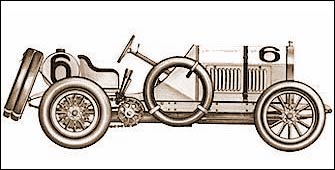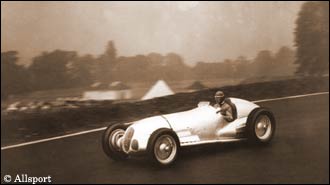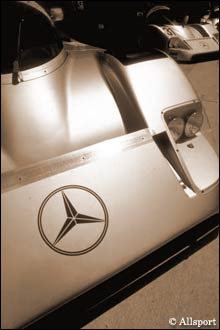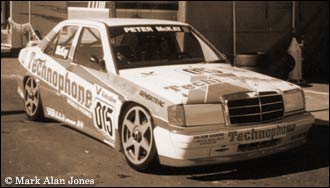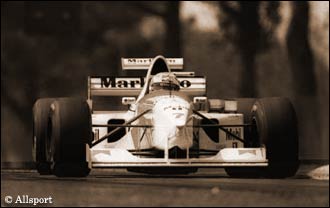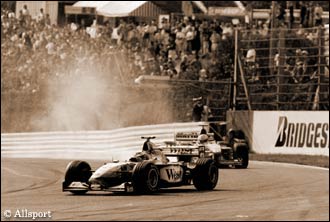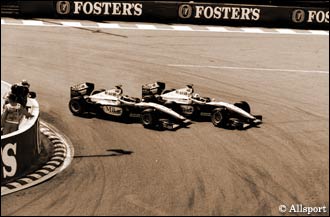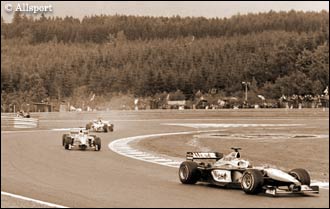|
||||||||
|
|
|||||||
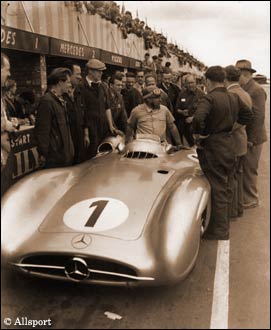 1954 A group of figures attend Juan Manuel Fangio, as the world champion climbs into his slipstreamer W196 grand prix car that would later would take Fangio to a perhaps disappointing fourth place in the British Grand Prix at Silverstone. In 1954 and 1955, the W196 would take Fangio to two drivers crowns. An era of Mercedes domination was cut short after the 300SL of Pierre Levegh flew into the crowd after colliding with a slower car during the 1955 Le Mans 24 Hours, killing more than 80 spectators. Mercedes perceived the stigma from the Le Mans disaster would haunt their motorsport efforts and retired from racing. At extreme right of the picture is legendary Mercedes motorsport team manager of the 30s & 50s, Alfred Neubauer. 1954 A group of figures attend Juan Manuel Fangio, as the world champion climbs into his slipstreamer W196 grand prix car that would later would take Fangio to a perhaps disappointing fourth place in the British Grand Prix at Silverstone. In 1954 and 1955, the W196 would take Fangio to two drivers crowns. An era of Mercedes domination was cut short after the 300SL of Pierre Levegh flew into the crowd after colliding with a slower car during the 1955 Le Mans 24 Hours, killing more than 80 spectators. Mercedes perceived the stigma from the Le Mans disaster would haunt their motorsport efforts and retired from racing. At extreme right of the picture is legendary Mercedes motorsport team manager of the 30s & 50s, Alfred Neubauer.
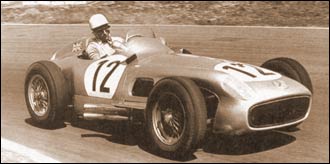
|
1955 The Mercedes W196 in all its glory at Aintree, 1955, with Stirling Moss on his way to an emotional debut victory in front of his home crowd. Moss and Fangio dominated Formula One in 1955. Ferrari were not in good shape, Lancia held promise but collapsed after Ascari's death, Maserati lacked a number one driver that could challenge and Vanwall were two years away from competitiveness. Against this backdrop Mercedes took all before them, winning in Belgium, Netherlands, Britain and Italy, only losing Monaco when trouble struck all three cars. At year's end, with June's disaster at Le Sarthe du Mans, the team was disbanded. |
|


The Original Benz |
||
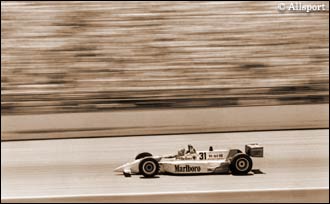 1994 In 1994, as it had for a long time, the Indianapolis 500 had different engine regulations than for the rest of the CART series, ostensibly to encourage US manufacturers to enter and compete against the domination of British-built engines such as the Ilmor and Cosworth. These regulations allowed for 3.43 litre two valve pushrod engines, as well as CART's 2.65 litre four valve overhead cam engines. These 3.43 litre engines were largely production based. Ilmor saw an opening to build a motor specifically to win Indy under these regulations, by taking the pushrod regulations and building a racing engine. That engine, badged as a Mercedes, was placed in the Penske chassis, and saw Emerson Fittipaldi, Al Unser Jr and Paul Tracy dominate the 1994 Indy 500, with Little Al giving Mercedes its first modern Indy 500 win. 1994 In 1994, as it had for a long time, the Indianapolis 500 had different engine regulations than for the rest of the CART series, ostensibly to encourage US manufacturers to enter and compete against the domination of British-built engines such as the Ilmor and Cosworth. These regulations allowed for 3.43 litre two valve pushrod engines, as well as CART's 2.65 litre four valve overhead cam engines. These 3.43 litre engines were largely production based. Ilmor saw an opening to build a motor specifically to win Indy under these regulations, by taking the pushrod regulations and building a racing engine. That engine, badged as a Mercedes, was placed in the Penske chassis, and saw Emerson Fittipaldi, Al Unser Jr and Paul Tracy dominate the 1994 Indy 500, with Little Al giving Mercedes its first modern Indy 500 win. |
|

The Original Mercedes 

The Original Daimler |
||||
 1996 It could only be Monaco. Mika Hakkinen in the McLaren MP4/11 Mercedes at Virage du Tabac. The McLaren-Mercedes combination continued to slowly gain momentum. In a year when the only show in town was the Williams FW18 Renault, McLaren continued to climb the slippery slope, with Hakkinen claiming several podium spots, ahead of the rest and not far from Benetton and Eddie Irvine. Power was still needed though. 1996 It could only be Monaco. Mika Hakkinen in the McLaren MP4/11 Mercedes at Virage du Tabac. The McLaren-Mercedes combination continued to slowly gain momentum. In a year when the only show in town was the Williams FW18 Renault, McLaren continued to climb the slippery slope, with Hakkinen claiming several podium spots, ahead of the rest and not far from Benetton and Eddie Irvine. Power was still needed though.
 |
|

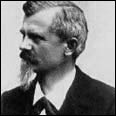
The Original Maybach 
|
||||
 1999 Mercedes returned to the burgeoning world of sports car racing in 1997. In 1998, Mercedes dominated the FIA GT series, with Klaus Ludwig & Ricardo Zonta winning the world championship from teammates Bernd Schneider & Mark Webber. However, early retirements would rob them of any chances in the 1998 Le Mans 24 Hours. After the cancellation of the 1999 GT series Mercedes pulled out all stops to develop the new Mercedes-Benz CLR model specifically for Le Mans. But Le Mans has never been a lucky place for Mercedes, with only two wins to their credit despite being heavily favoured or outright favourites on no less than ten occasions. Despite thousands of laps in testing, a major aerodynamic defect was found in the car when Mark Webber somersaulted at Indianapolis during qualifying. It happened again to Webber in the race morning warm-up on the Mulsanne. And finally a third time, this time Peter Dumbreck at Indianapolis in the early hours of the race. The surviving car was withdrawn shortly after, with Mercedes leaving Le Mans without success once again. Here, the surviving car of Bernd Schneider, Pedro Lamy and Franck Lagorce negotiates evening practice. 1999 Mercedes returned to the burgeoning world of sports car racing in 1997. In 1998, Mercedes dominated the FIA GT series, with Klaus Ludwig & Ricardo Zonta winning the world championship from teammates Bernd Schneider & Mark Webber. However, early retirements would rob them of any chances in the 1998 Le Mans 24 Hours. After the cancellation of the 1999 GT series Mercedes pulled out all stops to develop the new Mercedes-Benz CLR model specifically for Le Mans. But Le Mans has never been a lucky place for Mercedes, with only two wins to their credit despite being heavily favoured or outright favourites on no less than ten occasions. Despite thousands of laps in testing, a major aerodynamic defect was found in the car when Mark Webber somersaulted at Indianapolis during qualifying. It happened again to Webber in the race morning warm-up on the Mulsanne. And finally a third time, this time Peter Dumbreck at Indianapolis in the early hours of the race. The surviving car was withdrawn shortly after, with Mercedes leaving Le Mans without success once again. Here, the surviving car of Bernd Schneider, Pedro Lamy and Franck Lagorce negotiates evening practice. |
|
|||
| Mark Alan Jones | © 2007 autosport.com |
| Send comments to: jones@atlasf1.com | Terms & Conditions |

